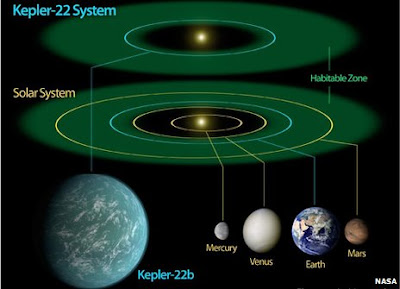Related
Stories
- Most liveable alien worlds ranked
- Hunt closes in on 'another Earth'
- Strangely silent star system seen
 |
| The planet lies about 15% closer to its star than the Earth is to the Sun |
Astronomers
have confirmed the existence of an Earth-like planet in the "habitable
zone" around a star not unlike our own.
The planet,
Kepler 22-b, lies about 600 light-years away and is about 2.4 times the size of
Earth, and has a temperature of about 22C.
It is the
closest confirmed planet yet to one like ours - an "Earth 2.0".
However,
the team does not yet know if Kepler 22-b is made mostly of rock, gas or
liquid.
During the
conference at which the result was announced, the Kepler team said that it had
spotted some 1,094 new candidate planets.
The Kepler
space telescope was designed to look at a fixed swathe of the night sky,
staring intently at about 150,000 stars. The telescope is sensitive enough to
see when a planet passes in front of its host star, dimming the star's light by
a minuscule amount.
Kepler
identifies these slight changes in starlight as candidate planets, which are
then confirmed by further observations by Kepler and other telescopes in orbit
and on Earth.
Kepler
Space Telescope
- Stares fixedly at a patch corresponding to 1/400th of the sky
- Looks at more than 155,000 stars
- Has so far found 2,326 candidate planets
- Among them are 207 Earth-sized planets, 10 of which are in the "habitable zone" where liquid water can exist
Kepler 22-b was one of 54 candidates reported by the Kepler team in February, and is just the first to be formally confirmed using other telescopes.
More of
these "Earth 2.0" candidates are likely to be confirmed in the near
future, though a redefinition of the habitable zone's boundaries has brought
that number down to 48.
Kepler 22-b
lies at a distance from its sun about 15% less than the distance from the Earth
to the Sun, and its year takes about 290 days. However, its sun puts out about
25% less light, keeping the planet at its balmy temperature that would support
the existence of liquid water.
The Kepler
team had to wait for three passes of the planet before upping its status from
"candidate" to "confirmed".
"Fortune
smiled upon us with the detection of this planet," said William Borucki,
Kepler principal investigator at Nasa's Ames Research Center.
"The
first transit was captured just three days after we declared the spacecraft
operationally ready. We witnessed the defining third transit over the 2010
holiday season."
The results
were announced at the Kepler telescope's first science conference, alongside
the staggering number of new candidate planets. The total number of candidates
spotted by the telescope is now 2,326 - of which 207 are approximately
Earth-sized.
In total,
the results suggest that planets ranging from Earth-sized to about four times
Earth's size - so-called "super-Earths" - may be more common than
previously thought.
Related Articles:
(Subjects: Benevolent Design, Channelling, Holy scriptures, Higher self, (Old) Souls, Universes, Big Bang, Galaxy/Solar system build for life, Astronomy, Life on Earth tried to start 5 times/ 5th time life started, Large Animals/No Humans, Asteroid belt, 7 Sisters/100.000 year ago Pleiadian Brothers and Sisters seeded Humans on earth, DNA, Humans Ascensiont with PleiadianDNA, Lemuria (Hawaii), 21-12-2012, 26.000 years cycle, 1987 - Harmonic convergence (11:11), Shift of Human Consciousness, Gaia, The Humanization of God, 1991 Russia falls, 1994 started 36 years galactic window (Presession), Mid point on 21-12-2012, Lemuria (Hawaii) center of the Earth time, Love (Mother & Child), Religion, Higher self, Global Unity,..... etc.) - New !







No comments:
Post a Comment